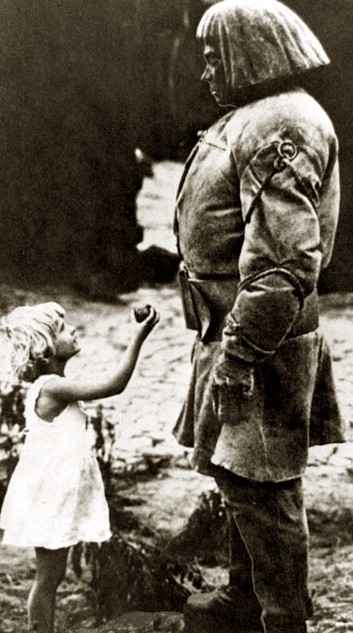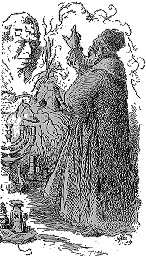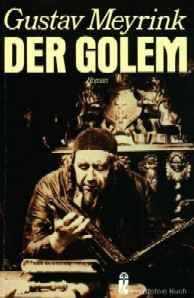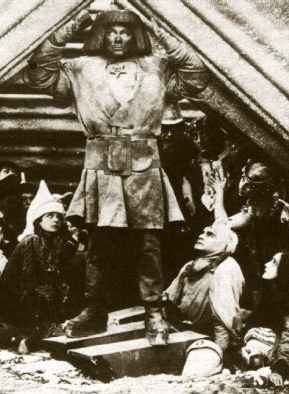|
Golem On a historical basis, it's not hard to see why Jewish people would want a superhero. You can only spend so much time being persecuted before you get tired of it.
On a historical basis, it's not hard to see why Jewish people would want a superhero. You can only spend so much time being persecuted before you get tired of it. In medieval times, the persecution was particularly intense and the solution was extreme, or so the story goes. There are several variations on the legend of the Golem, but the most widely known version places the activity in Prague during the 16th century. Our hero is Rabbi Loew, intrepid leader of the Prague Jewish community. According to legend, the Prague Gentiles had wronged the Jews in some way—the details of the complaint vary, but range anywhere from spreading nasty rumors about drinking the blood of children to an all-out pogrom. To make right this terrible wrong, Rabbi Loew draws on his skills as master of the Kabbalah, a collection of Jewish mystical writings which is considered one of the all-time classics of occultism. He uses instructions found in the Sepher Yetzirah, a book of the Kabbalah, to animate the form of a man made from clay.
As anyone who has read the Bible knows, it isn't nice to aspire to godhood. Instead of solving everyone's problems and righting injustices, the golem ran amok and began killing people, forcing Rabbi Loew to destroy it by erasing the mystical symbol. If this story sounds familiar, well, it is. The legend of the golem, and its cautionary tale formed the nugget of a tale which Mary Shelley would eventually rewrite as Frankenstein. While the book version of Frankenstein layers on new elements and a decent amount of creativity, all that was abandoned when the story made its way to Hollywood. Frankenstein and the Golem would battle it out on in the movies for almost 30 years without ever once appearing in the same movie. In 1910, the first adaptation of Frankenstein rolled out in the U.S. to very little fanfare. It ran all of 12 minutes. Versions of the story released to the public in 1915 and 1920 were little better, but both are now lost.
On the basis of pure cinematic merit, the Golem was kicking Frankenstein's ass pretty convincingly right up through 1931, when Boris Karloff forever seared the image of Victor F's Monster into the psyche of the filmgoing public. It can perhaps be considered a moral victory for the Golem. After all, Karloff's Monster is noticeably derivative of Wegener's Golem in its look, not to mention its behavior. In legend and on film, the Golem is not an intelligent creature. It follows directions at best, and runs around on murderous rampages at worst. Frankenstein's Monster, on the other hand, spouted philosophy and bemoaned its existential woes at great length, at least in the original novel. Karloff was more Wegener than Wegener, and the legacy of the 1931 Frankenstein remains one of the cinema's most enduring. Despite all this, the tale of the Golem has exercised an enduring effect on occultism over the course of centuries, along with related concepts like the Tibetan tupla and the Thelemic homunculus, a magical creation attempted by Aleister Crowley and Jack Parsons (unlike the Golem, the homunculus or moon-child was supposed to be the product of a sex act). Modern science has not, perhaps, absorbed as much of the cautionary tale's caution as one might hope, and occasional efforts at creating artificial life are sometimes named after Rabbi Loew's mythical monster. So far, none of these have gone on killing sprees. But do you really want to push your luck like that?
Sepher Yetzirah is a somewhat arcane account of the making of the universe, in which the relationship between Hebrew letters, numbers and mystical concepts are explained in a manner intended to illustrate how God created the universe. It's only when you truly understand all of that, by deciphering the arcane symbolism in the book, that the path to creating your life can be deduced through reverse engineering. After that, there are still two more major obstacles that remain in terms of creating a Golem to do your bidding. First, some traditions hold that only the most righteous of wise men can create a Golem. Obviously, if you're out there tinkering around with creating life for the fun and profit, you would automatically be disqualified from this category. Second, if you have to figure out all the secrets of the creation of the universe before you can figure out how to make a Golem, there's a pretty good chance you won't be so interested in actually having a Golem by the time you're done. Either you'll be so humbled by God's blueprint that you'll lose interest, or the vastness of so much forbidden knowledge will fry your brain into crispy ruination. But then, what else were you going to do with your brain? Be honest.
|
 Rabbi Loew animated the golem by means of a mystical symbol inscribed on a seal that was placed on the golem's forehead (around the area of the "Third Eye" in Eastern mysticism). The magical being came to life, following the orders of its creator... Or that was the plan, anyway.
Rabbi Loew animated the golem by means of a mystical symbol inscribed on a seal that was placed on the golem's forehead (around the area of the "Third Eye" in Eastern mysticism). The magical being came to life, following the orders of its creator... Or that was the plan, anyway.  Meanwhile, pioneering silent film director Paul Wegener was making his career out of the tale of the Golem to the silver screen as actor-director-writer in The Golem (1916), The Golem and the Dancing Girl (1917) and The Golem As He Came Into The World (1920, prequel to the 1916 version). The first two movies are lost, but the third one is considered something of a classic, with vivid visuals and special effects during the animation of the monster, and a timely message about anti-Semitism that fell on deaf ears in Wegener's native Germany.
Meanwhile, pioneering silent film director Paul Wegener was making his career out of the tale of the Golem to the silver screen as actor-director-writer in The Golem (1916), The Golem and the Dancing Girl (1917) and The Golem As He Came Into The World (1920, prequel to the 1916 version). The first two movies are lost, but the third one is considered something of a classic, with vivid visuals and special effects during the animation of the monster, and a timely message about anti-Semitism that fell on deaf ears in Wegener's native Germany.  Purists, of course, can always return to the original. The making of the golem is the ultimate test of Kabbalistic skill and a sign of great occult accomplishment. But if you've read the Sepher Yetzirah, you may have noticed that it doesn't seem to include a "how to make a golem" heading, at least not in the sense of "add 300 pounds of clay, stir for 30 minutes then reduce to a simmer and cover, occasionally stirring for two hours."
Purists, of course, can always return to the original. The making of the golem is the ultimate test of Kabbalistic skill and a sign of great occult accomplishment. But if you've read the Sepher Yetzirah, you may have noticed that it doesn't seem to include a "how to make a golem" heading, at least not in the sense of "add 300 pounds of clay, stir for 30 minutes then reduce to a simmer and cover, occasionally stirring for two hours."